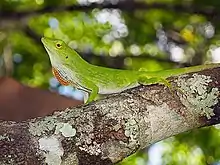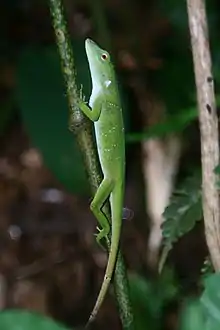Anolis biporcatus
Anolis biporcatus, also known as the neotropical green anole or giant green anole, is a species of anole.[2] It is found in forests, both disturbed and undisturbed, in Mexico, Central America, Colombia and Venezuela. More southern populations, in southwestern Colombia and western Ecuador, were recognized as a separate species, A. parvauritus, in 2017.[3]
| Neotropical green anole | |
|---|---|
 | |
| Scientific classification | |
| Domain: | Eukaryota |
| Kingdom: | Animalia |
| Phylum: | Chordata |
| Class: | Reptilia |
| Order: | Squamata |
| Suborder: | Iguania |
| Family: | Dactyloidae |
| Genus: | Anolis |
| Species: | A. biporcatus |
| Binomial name | |
| Anolis biporcatus Wiegmann, 1834 | |
| Synonyms | |
|
Norops biporcatus | |
As suggested by its common names, the neotropical green or giant green anole is mostly green in color and relatively large, among the largest anoles in the mainland of the Americas. Males have a snout–vent length of about 7.0–10.3 cm (2.8–4.1 in) and the females, which grow slightly larger, about 7.0–10.8 cm (2.8–4.3 in). In general, there is little sexual dimorphism in this species. The tail is roughly double the length of the snout-to-vent.[3]

See also
References
- "Anolis biporcatus | IUCN Red List". iucnredlist.org.
- Anolis biporcatus at the Reptarium.cz Reptile Database. Accessed 23 May 2014.
- Armstead; Ayala-Varela; Torres-Carvajal; Ryan; Poe (2017). "Systematics and ecology of Anolis biporcatus (Squamata: Iguanidae)". Salamandra. 52 (2): 285–293.
